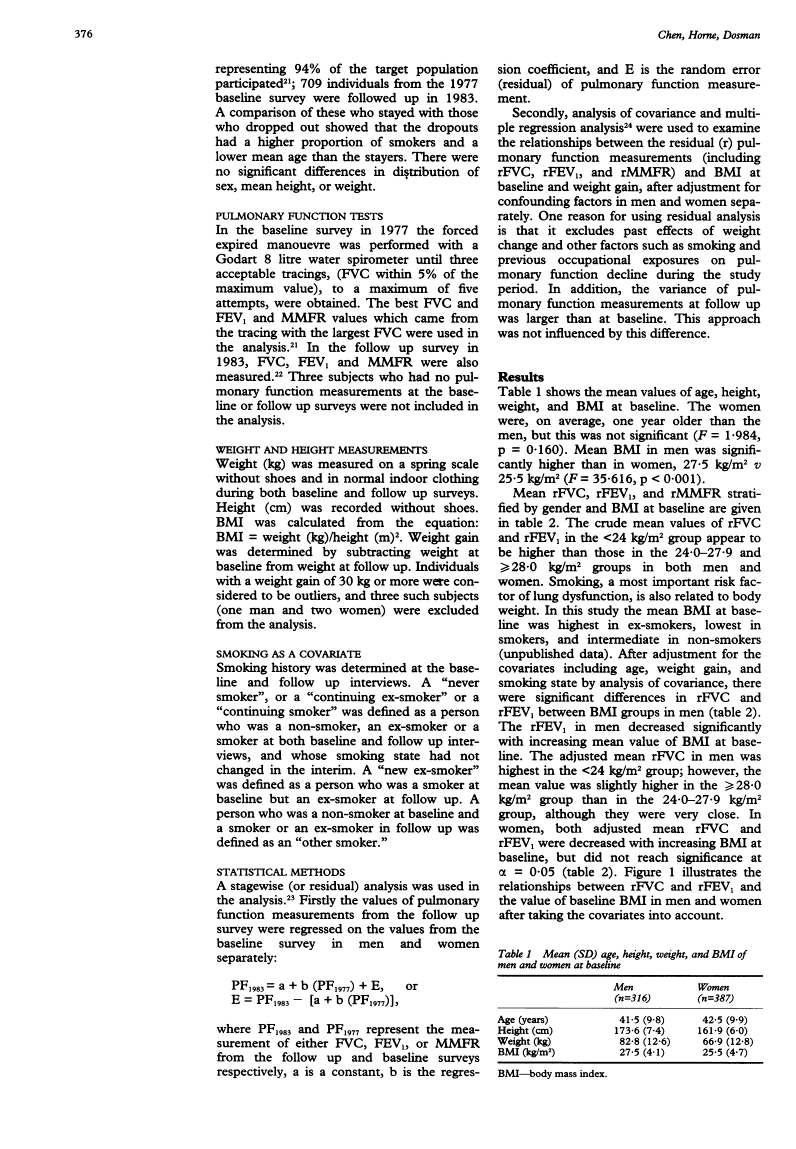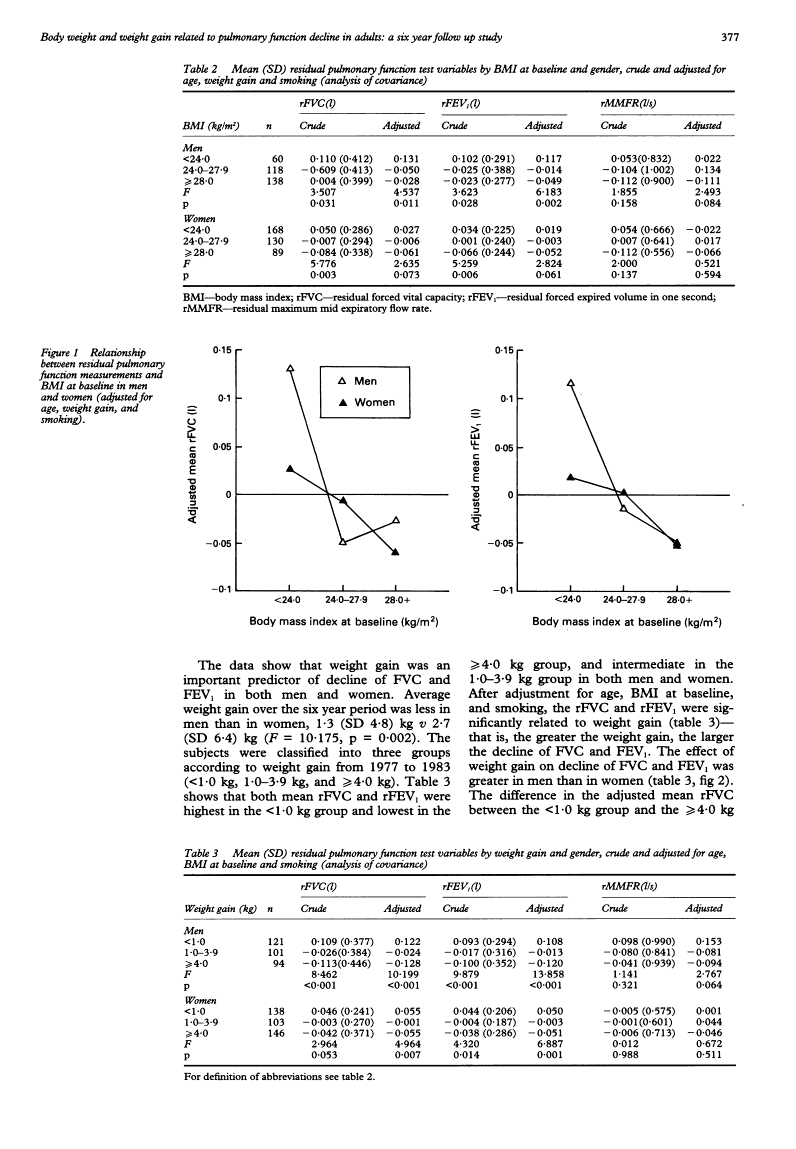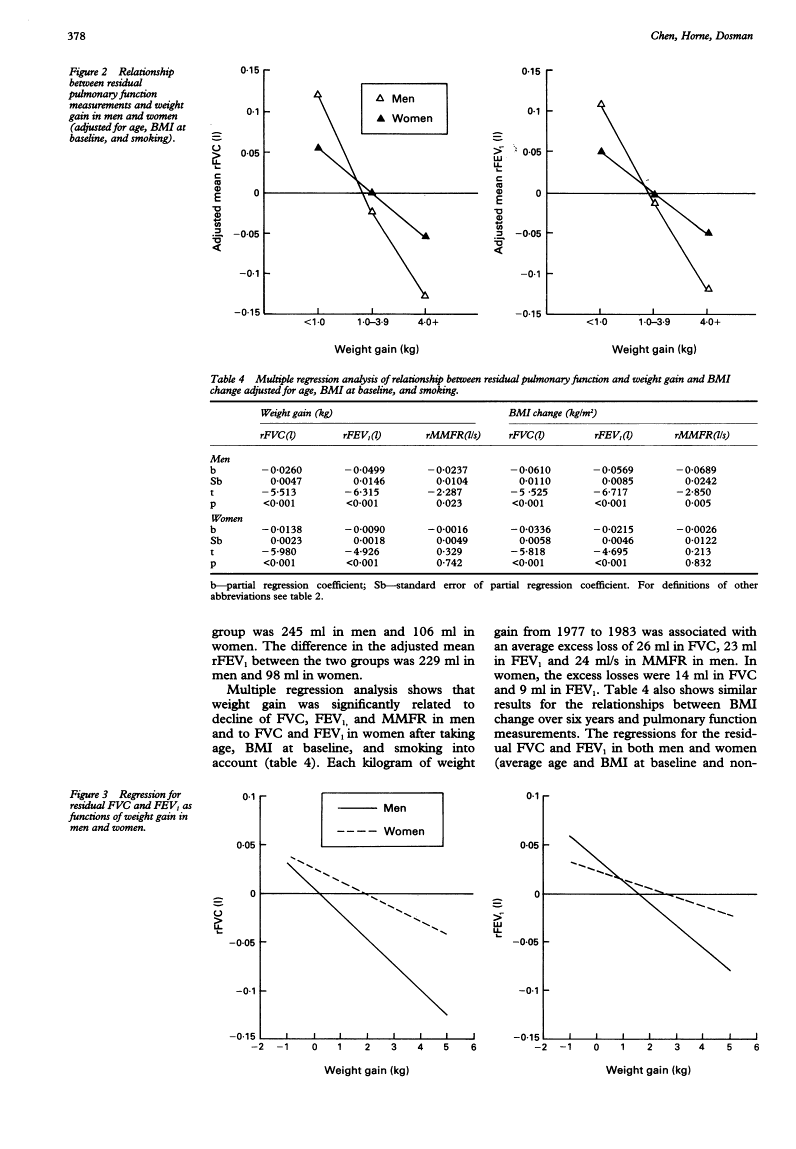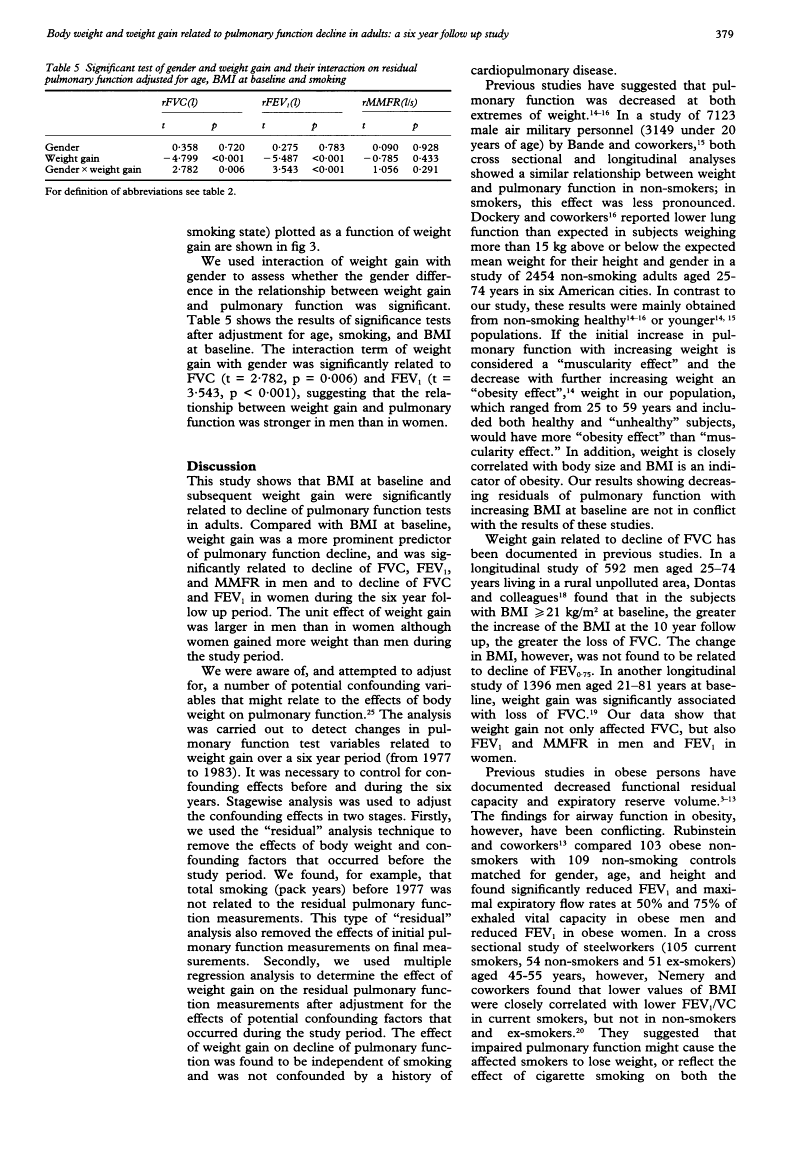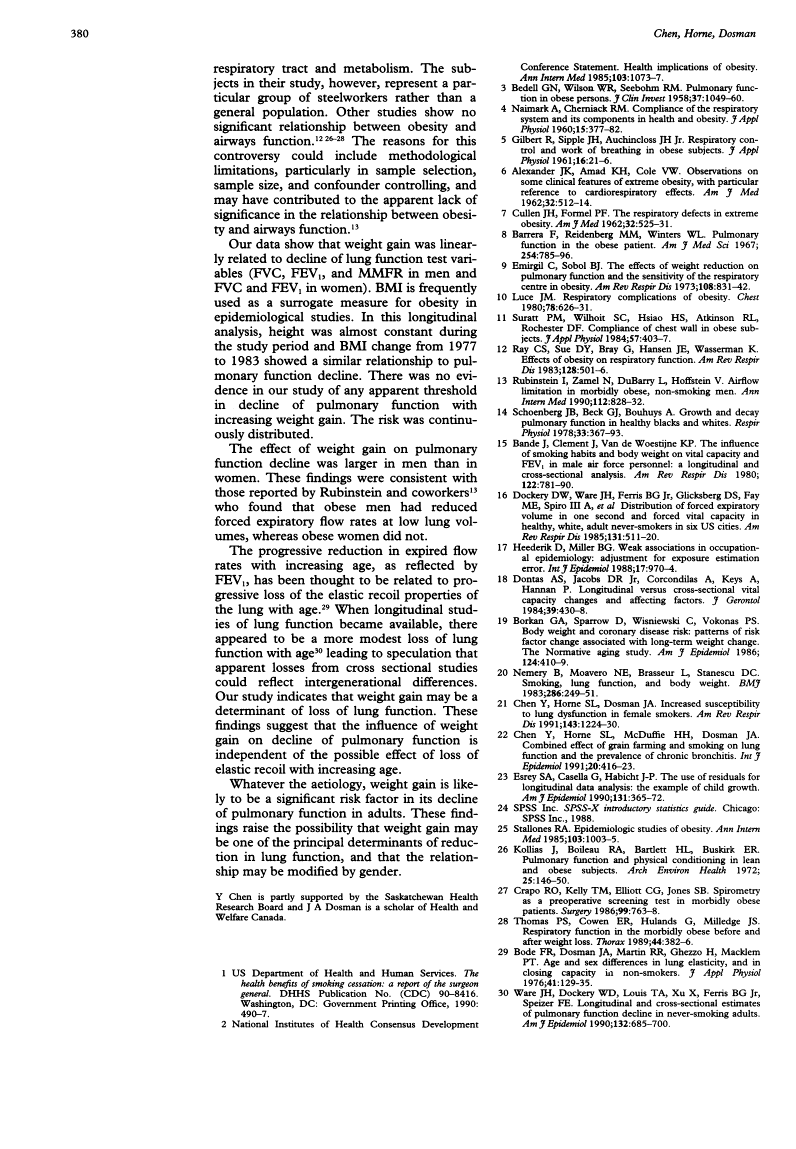Abstract
Background
Obesity increases the risk of cardiovascular disease, hypertension, diabetes, digestive diseases, and some cancers. Several studies have shown that excess weight or weight gain is related to pulmonary dysfunction, but this issue needs to be further clarified.Methods
The analysis was based on data of the Humboldt cohort study which was conducted in the town of Humboldt, Saskatchewan, Canada. The baseline survey in 1977 included 1202 adults, comprising 94% of all residents aged 25-59 years. Of these, 709 (59%) were followed up in 1983. Pulmonary function (forced vital capacity (FVC), forced expiratory volume in one second (FEV1) and maximal mid expiratory flow rate (MMFR) and weight were measured in both surveys. Weight gain was determined by subtracting weight at baseline from weight at follow up. A residual analysis was used to examine the relationship between body mass index (BMI) at baseline, weight gain, and pulmonary function decline.Results
Both BMI at baseline and weight gain were significantly related to pulmonary function at follow up. The effect of weight gain during the study period, however, was more prominent. The results showed that both mean residual FVC and FEV1 were highest in the group that gained < 1.0 kg, lowest in the group that gained > or = 4.0 kg, and intermediate in the group that gained 1.0-3.9 kg in both men and women after taking age, BMI at baseline, and smoking into account. The effect of weight gain on pulmonary function was greater in men than in women. Multiple regression analysis showed that each kilogram of weight gain was associated with an excess loss of 26 ml in FVC and 23 ml in FEV1 in men, and 14 ml and 9 ml respectively in women.Conclusions
Weight gain is significantly related to lung dysfunction. The effect of weight gain on pulmonary function is greater in men than in women.Free full text

Body weight and weight gain related to pulmonary function decline in adults: a six year follow up study.
Abstract
BACKGROUND--Obesity increases the risk of cardiovascular disease, hypertension, diabetes, digestive diseases, and some cancers. Several studies have shown that excess weight or weight gain is related to pulmonary dysfunction, but this issue needs to be further clarified. METHODS--The analysis was based on data of the Humboldt cohort study which was conducted in the town of Humboldt, Saskatchewan, Canada. The baseline survey in 1977 included 1202 adults, comprising 94% of all residents aged 25-59 years. Of these, 709 (59%) were followed up in 1983. Pulmonary function (forced vital capacity (FVC), forced expiratory volume in one second (FEV1) and maximal mid expiratory flow rate (MMFR) and weight were measured in both surveys. Weight gain was determined by subtracting weight at baseline from weight at follow up. A residual analysis was used to examine the relationship between body mass index (BMI) at baseline, weight gain, and pulmonary function decline. RESULTS--Both BMI at baseline and weight gain were significantly related to pulmonary function at follow up. The effect of weight gain during the study period, however, was more prominent. The results showed that both mean residual FVC and FEV1 were highest in the group that gained < 1.0 kg, lowest in the group that gained > or = 4.0 kg, and intermediate in the group that gained 1.0-3.9 kg in both men and women after taking age, BMI at baseline, and smoking into account. The effect of weight gain on pulmonary function was greater in men than in women. Multiple regression analysis showed that each kilogram of weight gain was associated with an excess loss of 26 ml in FVC and 23 ml in FEV1 in men, and 14 ml and 9 ml respectively in women. CONCLUSIONS--Weight gain is significantly related to lung dysfunction. The effect of weight gain on pulmonary function is greater in men than in women.
Full text
Full text is available as a scanned copy of the original print version. Get a printable copy (PDF file) of the complete article (1007K), or click on a page image below to browse page by page. Links to PubMed are also available for Selected References.
Selected References
These references are in PubMed. This may not be the complete list of references from this article.
- BEDELL GN, WILSON WR, SEEBOHM PM. Pulmonary function in obese persons. J Clin Invest. 1958 Jul;37(7):1049–1060. [Europe PMC free article] [Abstract] [Google Scholar]
- NAIMARK A, CHERNIACK RM. Compliance of the respiratory system and its components in health and obesity. J Appl Physiol. 1960 May;15:377–382. [Abstract] [Google Scholar]
- GILBERT R, SIPPLE JH, AUCHINCLOSS JH., Jr Respiratory control and work of breathing in obese subjects. J Appl Physiol. 1961 Jan;16:21–26. [Abstract] [Google Scholar]
- Barrera F, Reidenberg MM, Winters WL. Pulmonary function in the obese patient. Am J Med Sci. 1967 Dec;254(6):785–796. [Abstract] [Google Scholar]
- Emirgil C, Sobol BJ. The effects of weight reduction on pulmonary function and the sensitivity of the respiratory center in obesity. Am Rev Respir Dis. 1973 Oct;108(4):831–842. [Abstract] [Google Scholar]
- Luce JM. Respiratory complications of obesity. Chest. 1980 Oct;78(4):626–631. [Abstract] [Google Scholar]
- Suratt PM, Wilhoit SC, Hsiao HS, Atkinson RL, Rochester DF. Compliance of chest wall in obese subjects. J Appl Physiol Respir Environ Exerc Physiol. 1984 Aug;57(2):403–407. [Abstract] [Google Scholar]
- Ray CS, Sue DY, Bray G, Hansen JE, Wasserman K. Effects of obesity on respiratory function. Am Rev Respir Dis. 1983 Sep;128(3):501–506. [Abstract] [Google Scholar]
- Rubinstein I, Zamel N, DuBarry L, Hoffstein V. Airflow limitation in morbidly obese, nonsmoking men. Ann Intern Med. 1990 Jun 1;112(11):828–832. [Abstract] [Google Scholar]
- Schoenberg JB, Beck GJ, Bouhuys A. Growth and decay of pulmonary function in healthy blacks and whites. Respir Physiol. 1978 Jun;33(3):367–393. [Abstract] [Google Scholar]
- Bande J, Clément J, Van de Woestijne KP. The influence of smoking habits and body weight on vital capacity and FEV1 in male Air Force personnel: a longitudinal and cross-sectional analysis. Am Rev Respir Dis. 1980 Nov;122(5):781–790. [Abstract] [Google Scholar]
- Dockery DW, Ware JH, Ferris BG, Jr, Glicksberg DS, Fay ME, Spiro A, 3rd, Speizer FE. Distribution of forced expiratory volume in one second and forced vital capacity in healthy, white, adult never-smokers in six U.S. cities. Am Rev Respir Dis. 1985 Apr;131(4):511–520. [Abstract] [Google Scholar]
- Heederik D, Miller BG. Weak associations in occupational epidemiology: adjustment for exposure estimation error. Int J Epidemiol. 1988 Dec;17(4):970–974. [Abstract] [Google Scholar]
- Dontas AS, Jacobs DR, Jr, Corcondilas A, Keys A, Hannan P. Longitudinal versus cross-sectional vital capacity changes and affecting factors. J Gerontol. 1984 Jul;39(4):430–438. [Abstract] [Google Scholar]
- Borkan GA, Sparrow D, Wisniewski C, Vokonas PS. Body weight and coronary disease risk: patterns of risk factor change associated with long-term weight change. The Normative Aging Study. Am J Epidemiol. 1986 Sep;124(3):410–419. [Abstract] [Google Scholar]
- Nemery B, Moavero NE, Brasseur L, Stănescu DC. Smoking, lung function, and body weight. Br Med J (Clin Res Ed) 1983 Jan 22;286(6361):249–251. [Europe PMC free article] [Abstract] [Google Scholar]
- Chen Y, Horne SL, Dosman JA. Increased susceptibility to lung dysfunction in female smokers. Am Rev Respir Dis. 1991 Jun;143(6):1224–1230. [Abstract] [Google Scholar]
- Chen Y, Horne SL, McDuffie HH, Dosman JA. Combined effect of grain farming and smoking on lung function and the prevalence of chronic bronchitis. Int J Epidemiol. 1991 Jun;20(2):416–423. [Abstract] [Google Scholar]
- Esrey SA, Casella G, Habicht JP. The use of residuals for longitudinal data analysis: the example of child growth. Am J Epidemiol. 1990 Feb;131(2):365–372. [Abstract] [Google Scholar]
- Stallones RA. Epidemiologic studies of obesity. Ann Intern Med. 1985 Dec;103(6 ):1003–1005. [Abstract] [Google Scholar]
- Kollias J, Boileau RA, Barlett HL, Buskirk ER. Pulmonary function and physical conditioning in lean and obese subjects. Arch Environ Health. 1972 Aug;25(2):146–150. [Abstract] [Google Scholar]
- Crapo RO, Kelly TM, Elliott CG, Jones SB. Spirometry as a preoperative screening test in morbidly obese patients. Surgery. 1986 Jun;99(6):763–768. [Abstract] [Google Scholar]
- Thomas PS, Cowen ER, Hulands G, Milledge JS. Respiratory function in the morbidly obese before and after weight loss. Thorax. 1989 May;44(5):382–386. [Europe PMC free article] [Abstract] [Google Scholar]
- Bode FR, Dosman J, Martin RR, Ghezzo H, Macklem PT. Age and sex differences in lung elasticity, and in closing capacity in nonsmokers. J Appl Physiol. 1976 Aug;41(2):129–135. [Abstract] [Google Scholar]
- Ware JH, Dockery DW, Louis TA, Xu XP, Ferris BG, Jr, Speizer FE. Longitudinal and cross-sectional estimates of pulmonary function decline in never-smoking adults. Am J Epidemiol. 1990 Oct;132(4):685–700. [Abstract] [Google Scholar]
Associated Data
Articles from Thorax are provided here courtesy of BMJ Publishing Group
Full text links
Read article at publisher's site: https://doi.org/10.1136/thx.48.4.375
Read article for free, from open access legal sources, via Unpaywall:
https://thorax.bmj.com/content/48/4/375.full.pdf
Citations & impact
Impact metrics
Article citations
Relationship between obesity, body composition, and pulmonary function among Korean adults aged 40 years and older.
Sci Rep, 14(1):19798, 27 Aug 2024
Cited by: 0 articles | PMID: 39187563 | PMCID: PMC11347702
Preserved Ratio Impaired Spirometry (PRISm): A Global Epidemiological Overview, Radiographic Characteristics, Comorbid Associations, and Differentiation from Chronic Obstructive Pulmonary Disease.
Int J Chron Obstruct Pulmon Dis, 19:753-764, 15 Mar 2024
Cited by: 0 articles | PMID: 38505581 | PMCID: PMC10949882
Review Free full text in Europe PMC
Pulmonary Function Test and Obstructive Sleep Apnea Hypopnea Syndrome in Obese Adults: A Retrospective Study.
Int J Chron Obstruct Pulmon Dis, 18:1019-1030, 05 Jun 2023
Cited by: 3 articles | PMID: 37304766 | PMCID: PMC10253010
Spirometry profiles among pregnant and non-pregnant African women: a cross-sectional study.
BMC Womens Health, 22(1):483, 02 Dec 2022
Cited by: 1 article | PMID: 36461083 | PMCID: PMC9716166
The global lung function initiative 2021 (GLI-2021) norms provide mixed results for static lung volumes (SLVs) in Algerian adults.
Libyan J Med, 17(1):2059893, 01 Dec 2022
Cited by: 2 articles | PMID: 35379081 | PMCID: PMC8986198
Go to all (94) article citations
Similar Articles
To arrive at the top five similar articles we use a word-weighted algorithm to compare words from the Title and Abstract of each citation.
Body mass index and weight change are associated with adult lung function trajectories: the prospective ECRHS study.
Thorax, 75(4):313-320, 25 Feb 2020
Cited by: 30 articles | PMID: 32098862 | PMCID: PMC7231449
Effect of weight gain on pulmonary function after smoking cessation in the Lung Health Study.
Am J Respir Crit Care Med, 157(3 pt 1):866-872, 01 Mar 1998
Cited by: 52 articles | PMID: 9517604
Body composition and pulmonary function in the elderly: a 7-year longitudinal study.
Int J Obes (Lond), 32(9):1423-1430, 22 Jul 2008
Cited by: 37 articles | PMID: 18645577
Symptoms and lung function decline in a middle-aged cohort of males and females in Australia.
Int J Chron Obstruct Pulmon Dis, 11:1097-1103, 26 May 2016
Cited by: 6 articles | PMID: 27307725 | PMCID: PMC4887046

